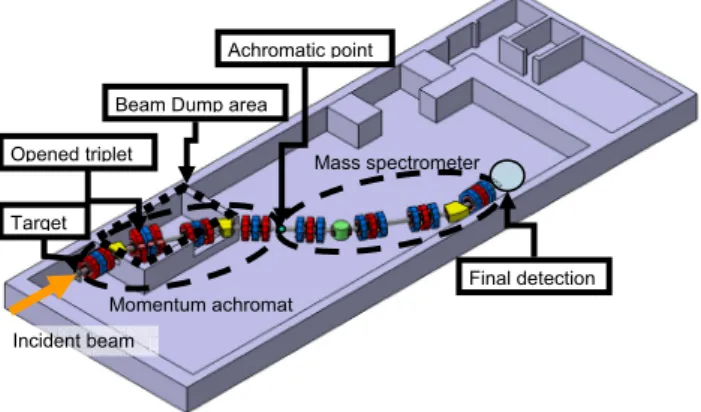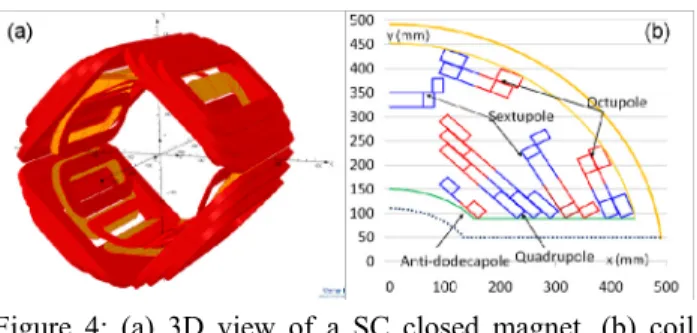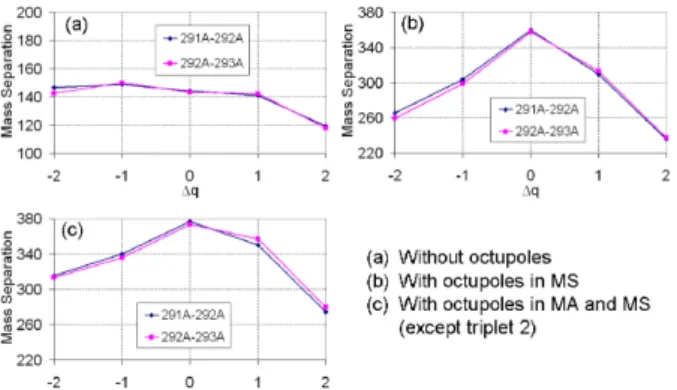HAL Id: in2p3-00496346
http://hal.in2p3.fr/in2p3-00496346
Submitted on 30 Jun 2010HAL is a multi-disciplinary open access archive for the deposit and dissemination of sci-entific research documents, whether they are pub-lished or not. The documents may come from teaching and research institutions in France or abroad, or from public or private research centers.
L’archive ouverte pluridisciplinaire HAL, est destinée au dépôt et à la diffusion de documents scientifiques de niveau recherche, publiés ou non, émanant des établissements d’enseignement et de recherche français ou étrangers, des laboratoires publics ou privés.
Optical studies for the super separator spectrometer S3
D. Boutin, M. Authier, F. Déchery, O. Delferrière, A. Drouart, J. Payet, D.
Uriot, A.M. Amthor, H. Savajols, M.H. Stodel, et al.
To cite this version:
D. Boutin, M. Authier, F. Déchery, O. Delferrière, A. Drouart, et al.. Optical studies for the super separator spectrometer S3. 1st International Particle Accelerator Conference (IPAC 2010), May 2010, Kyoto, Japan. pp.4464-4466. �in2p3-00496346�
OPTICAL STUDIES FOR THE SUPER SEPARATOR SPECTROMETER S
3D. Boutin
#, M. Authier, F. Dechery, O. Delferrière, A. Drouart, J. Payet, D. Uriot,
CEA, Gif-sur-Yvette, France
M. Amthor, H. Savajols, M.-H. Stodel, GANIL, Caen, France
S. Manikonda, J. Nolen, ANL, Argonne, IL 60439, USA
Abstract
S3 (Super Separator Spectrometer) [1] is a future device
designed for experiments with the high intensity heavy ion stable beams of SPIRAL2 [2] at GANIL (Caen, France). It will include a target resistant to these very high intensities, a first stage momentum achromat for primary beam extraction and suppression, a second stage mass spectrometer and a dedicated detection system. This spectrometer includes large aperture quadrupole triplets with embedded multipolar corrections. To enable the primary beam extraction one triplet has to be opened on one side, which requires an appropriate design of such a multipolar magnet.
The final mass separation power required for S3 needs
a careful design of the optics with a high level of aberration correction. Multiple symmetric lattices were studied for this purpose. A 4-fold symmetric lattice and the achieved results are described in this paper.
INTRODUCTION
The S3 spectrometer will use the high intensity stable
ion beams (up to 50 kW) produced by the SPIRAL2 accelerator to investigate fusion-evaporation reactions. Such reactions allow to study super heavy element (SHE) synthesis, very heavy element (VHE) spectroscopy, mirror nuclides (N=Z) spectroscopy and transfer reactions of light nuclides.
The main characteristics needed for these studies are: • A maximum magnetic rigidity of 1.8 Tm.
• A maximum electric rigidity of 12 MV. • A mass resolution of 1/300.
As the reaction products have large angular, energy and charge-state distributions, the S3 spectrometer must have:
• An angular acceptance of ±50 mrad, horizontal and vertical.
• A magnetic rigidity acceptance of ±7 %.
• A state acceptance of ±10 % (e.g. ±2 charge-states around the reference charge-state).
The primary beam suppression must be up to 1013 to
allow easy nuclei identification. At last, the spectrometer must fit a 26 x 12 m2 area, which is the allocated space
inside the S3 experimental hall.
The S3 spectrometer (Fig. 1) is divided in two stages.
The first one is a momentum achromat (MA) which will perform the separation between the reaction products and the primary beam. It must achieve a primary beam suppression of at least 103. The second stage is a mass
separator (MS) which must reach the final rejection and a 1/300 mass separation.
The MA has to operate with magnetic rigidities of recoil products up to 1.8 Tm. Depending on the type of reactions, a fraction of the primary beam is outside the spectrometer acceptance. The multipoles following the first dipole must have a vertical gap on one side to allow the primary beam extraction, and to prevent damages. A set of movable small beam stoppers, located at the dispersive focal plane, have to suppress the fraction of the projectile beam still in the momentum acceptance. Slits located at the MA image point have to reduce the residual projectile beam by at least a factor of 103. A minimum
free space of 1.6 m has to be preserved around the MA image point.
The MS needs a combination of an electrostatic dipole and a magnetic dipole to make a mass separation. To reach the mass separation at the MS image point (F4), the electrostatic dipole must have a length of at least 1.3 m, and an achievable field of 3 MV/m. The maximum electric rigidity leads to a limit of 1.2 Tm for the MS maximum magnetic rigidity. As the primary beam electric rigidity is different from the recoils products, the electrostatic dipole allows the final rejection of 1013.
The aperture diameter of all multipoles has to be 300 mm to obtain the large acceptances. To fit the allocated space, triplets of multipoles are used. A careful correction of aberrations is needed to achieve the required mass separation. Higher-order correctors, sextupole and octupoles, have to be superimposed to the main quadrupole component of the multipoles.
Figure 1: S3 implantation in the experimental hall.
S
3OPTICS DESCRIPTION
The main guideline is to conceive the most possibly symmetric structure. A 4-fold symmetric lattice [3] is presented below. The basic cell of this lattice is composed of a fixed drift, a quadrupole triplet and a half-dipole. The quadrupole strengths and the drift between the triplet and
Momentum achromat
Mass spectrometer Beam Dump area
Achromatic point Final detection Target Opened triplet Incident beam ___________________________________________ #david.boutin@cea.fr
THPD079 Proceedings of IPAC’10, Kyoto, Japan
4464
05 Beam Dynamics and Electromagnetic Fields D01 Beam Optics - Lattices, Correction Schemes, Transport
the dipole are adjusted in order to give a first-order matrix with null diagonal elements. This cell is repeated by mirror symmetry and combined. The first-order matrix of two cells is then minus identity (-I). By combination of two groups one obtains a separator stage of the spectrometer with identity (I) first-order matrix (Fig. 2). Each separator stage is achromatic separately. Such optical design insures the cancellation of the geometrical second-order matrix elements [3]. In the MS, the two dipoles are not the same nature so the symmetry and the 2nd order terms cancellation is not perfect.
Figure 2: Optical functions of the spectrometer, horizontal beta function (red line), vertical beta function (blue line), and dispersion function (green line). The basic cells defined in the first-order optics are indicated with square black boxes, as well as the combinations making unitary transfer matrices.
For each stage, the initial drift is repeated 4 times for symmetry reasons, leading to unnecessary space as each drift is not adjusted independently to the experimental needs. This is a disadvantage of such configuration.
Sextupoles components are inserted in each multipole for the correction of higher-order aberrations. Octupole components could improve this correction, and the effects of their insertion in each separation stage will be studied.
MAGNET DESIGNS
The classical iron dominated magnet and the superconducting (SC) magnet technologies have been envisaged for the closed multipoles and for the open multipoles (2nd triplet) as well. Octupoles were considered
only in the SC technology case.
Figure 3: 2D views of closed (a) and open (b) iron dominated multipoles. The dimensions are in mm.
Room Temperature Iron Dominated Multipoles
The magnet shapes are shown in Figure 3. The pole geometry was optimized in order to reduce the iron saturation down to 1.55 T. For the open magnets, the sextupolar component is obtained by subtraction of two dipolar fields; this allows a vertical gap around the horizontal axis, but a residual dipolar component remains. For closed magnets, the sextupolar component is achieved with a set of coils placed around the beam pipe in a sextupolar arrangement, as proposed by GANIL [4].
Superconducting Multipoles
Flat racetrack coil configurations were proposed by Irfu/SACM [5] for the closed and open SC multipoles (Fig. 4). The flat racetrack coils leads to a simplification of the coil winding, which has an impact on the magnet cost. Quadrupole, sextupole, and octupole components can be inserted in the same multipole. Originally, the sextupole design for the open multipoles use the same concept than to the open room temperature case. A new symmetric coil configuration has been proposed for the sextupole without the residual dipolar component. It can include an octupole component as well.
HIGHER-ORDER OPTIMIZATIONS
Optimization Strategy
The higher-order optimizations were performed with the tracking code TraceWin [6]. The code transports a cloud of particles through a beam line, taking into account all orders. The simulated beam has the same kinematic distribution than the recoil products after the target. The
100Sn reaction products were chosen for the optimization
because this nuclide has distributions similar to the nominal acceptance of the spectrometer (σ(x)=0.5mm, σ(x’)=σ(y’)=17.8mrad, Δy=±5mm (uniform distribution), σ(δp/p)=3.7%.). The retained optimization method uses as variables all the sextupoles, all the octupoles whether they are inserted, and the last quadrupole triplet. The goal is to maximize the mass separation of 3 different beams transported to the focal plane F4.This is achieved by a global minimization of all higher-order aberrations.
The TraceWin code tracks successively 3 charge-states of the same particle distribution, which cover the useful final focal plane area (± 50 mm in the horizontal plane). Once the optimization has converged, the magnet setting is adapted to the 292116 super-heavy element reaction case
Figure 4: (a) 3D view of a SC closed magnet, (b) coil layout of a SC open magnet.
Proceedings of IPAC’10, Kyoto, Japan THPD079
05 Beam Dynamics and Electromagnetic Fields
(48Ca + 248Cm → 4n + 292116). The spectrometer mass
separation power is then calculated from the beam FWHM sizes and positions at F4 between neighboring nucleis (Fig. 5). The same first-order lattice is employed for all the optimizations, in order to compare the different magnet technologies for each combination of multipoles.
Figure 5: Distribution of the 292116 reaction products at
F4. Five charge-states of three isotopes around 292116 are
displayed.
Optimization Results
The first simulations were performed with a theoretical modelling of the multipoles. They have shown that sextupole correctors are needed in all multipoles, including the open multipoles.
Afterwards, this modelling was replaced by closed magnet 3D field maps. It has to be noted that TraceWin doesn’t implement dipole field maps yet. To reach the wanted mass separation, a correction with octupolar components in the multipoles is needed (Fig. 6). Such correction could be achieved in the MA also with dipole edge curvatures. In the MS, this type of correction cannot be done with an electrostatic dipole, so only octupole components are possible. This conducts to the use of the SC technology for the MS multipoles.
Figure 6: Mass separation power with closed multipoles. Δq =0 corresponds to the charge-state q=26.
At last, open multipole field maps were introduced in the 2nd triplet. The best results on average have been
obtained with the SC symmetric coil configuration (Fig.
7). In addition, this design authorizes the insertion of octupole components.
Figure 7: Mass separation power with open multipoles. Δq =0 corresponds to the charge-state q=26.
The overall transmission for the five charge-states of the 292116 reaction products has been calculated. The
results, between 52% and 57%, are comparable for all cases. One example of SHE transmission with SC open multipole insertion is presented in Figure 8.
Figure 8: Example of SHE transmission with open multipoles. Δq =0 corresponds to the charge-state q=26.
CONCLUSION
We have studied a 4-fold symmetric lattice for the S3
spectrometer. The separation goal is reached for 4 charge-states out of 5, for the best results. The sextupolar chromatic correctors are needed everywhere in the dispersive regions. Octupolar corrections in the MS and the MA improve significantly the mass separation. This means that superconducting technology must be envisaged for the MS. An octupolar correction can be done in the MA also with dipole edge curvatures but without flexibility. Superconducting open multipoles give better results than conventional ones. The definitive spectrometer structure is still on development.
REFERENCES
[1] A. Drouart et al., Nucl. Phys. A 834 (2010) 747c. [2] SPIRAL2, http://pro.ganil-spiral2.eu/spiral2
[3] B. Erdelyi et al., Phys. Rev. ST Accel. Beams 10, 064002 (2007).
[4] M.-H. Stodel, « Synthèse de l’étude des quadrupoles de la salle S3 », 04/11/2009
[5] O.Delferrière et al., these proceedings. [6] D. Uriot, TraceWin code:
http://irfu.cea.fr/Sacm/logiciels/index3.php
THPD079 Proceedings of IPAC’10, Kyoto, Japan
4466
05 Beam Dynamics and Electromagnetic Fields D01 Beam Optics - Lattices, Correction Schemes, Transport


